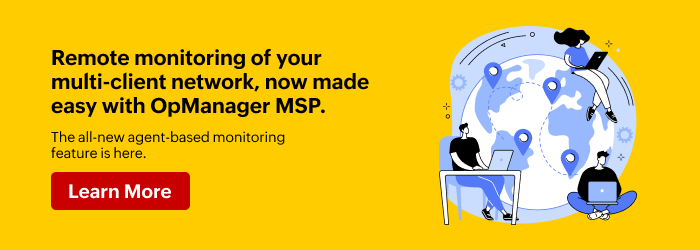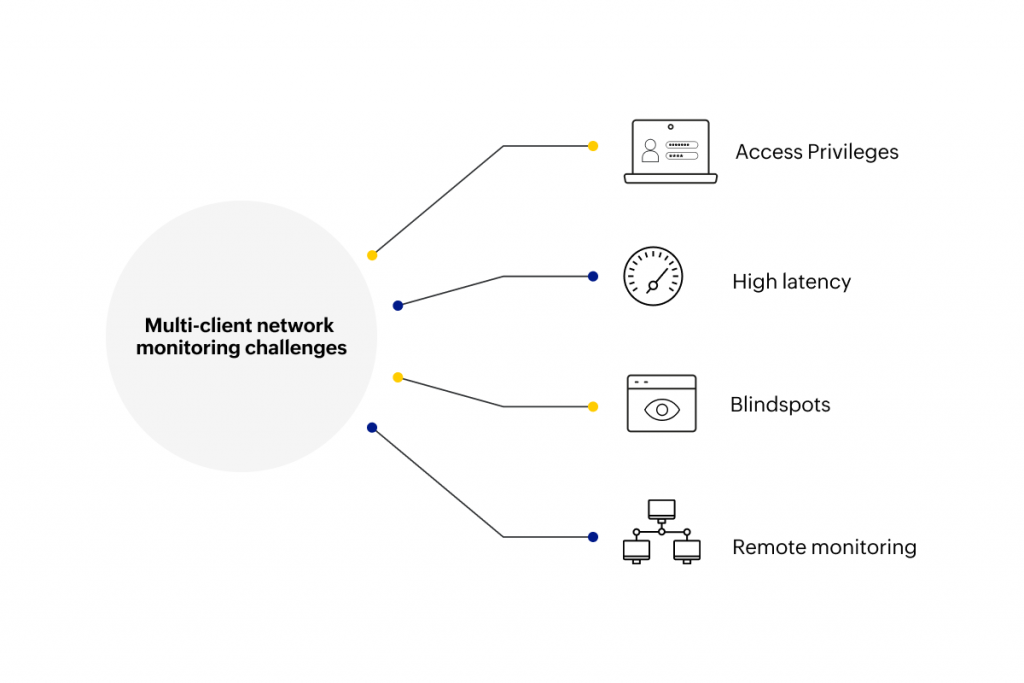
Monitoring a network for its uptime and peak performance is crucial. By tracking network performance, organizations can better understand their network requirements, gain in-depth visibility, identify mishaps quickly, and roll out remediation measures. However, this is easier said than done.
The complexity only increases when the network is an MSP’s. Monitoring a widespread multi-client network is a tedious task, since MSPs have to ensure the availability, optimum performance, and the security of not just their network, but their clients’ networks too.
In order to do so, MSPs must deploy a network monitoring solution that fetches a network devices’ real-time metrics using agentless or agent-based monitoring methods and raises alerts when they’re beyond optimum levels. Based on the retrieved data, network admins can initiate corrective actions to avoid any potential mishaps.
Agent-based and agentless monitoring differ in one key aspect: the data collection method. Agent-based monitoring tool deploys a lightweight piece of software known as an agent on a network device. The agent collects the device’s performance stats and sends out https requests to the central monitoring solution. The solution then receives the data from the agent and correlates and analyzes the retrieved metrics. This offers distinct advantages:
- Since the deployed agent can be configured to send only selective metrics, this helps MSP admins to have device-level customization on the information sent.
- Agent-based monitoring tool mitigates security concerns since the flow of information is uni-directional, i.e., only the agent can communicate with the monitoring solution, and not the other way around.
- Since the data is collected and stored locally, the strain on the central monitoring solution reduces drastically. Furthermore, even if the connection with the central monitoring solution goes down, the data will still be available once the monitoring solution is back up.
Agentless monitoring, on the other hand, relies on secure communication protocols for transmitting data. The central monitoring solution polls the devices at regular intervals and transmits data via communication protocols such as SNMP, WMI, CLI, etc. Unlike agent-based monitoring, the agentless method does not require any software to be installed on the end device, making it easier to deploy and scale.
To learn more about the differences between agent-based and agentless monitoring, check out this page.
In the rest of this blog, we’ll discuss:
- Challenges in monitoring multi-client networks
- How agent-based monitoring helps you monitor remote networks
- How OpManager MSP has got you covered for both agentless and agent-based monitoring
Challenges in monitoring multi-client networks
Let’s explore some of the challenges associated with multi-client monitoring.
- Access privileges: To monitor multi-client networks with an agent, MSPs need access to device credentials. However, sharing such extensive access might raise security concerns.
- Higher latency and traffic constraints: Since the server-based monitoring approach uses communication protocols for data transmission, the efficiency of the central motioning solution can take a hit, leading to higher latency. Moreover, data transmission generates huge amounts of network traffic and might cause congestion and delays.
- Blindspots: When the connection between a remote device and the central monitoring solution goes down, it is not possible to retrieve data. This gives rise to performance blindspots.
- Remote monitoring: More often than not, multi-client networks are spread across different geographical areas. Collecting and analyzing the metrics of remote devices from a central console is easier said than done. Moreover, when data is transferred from remote devices, they are prone to interceptions and tampering. This introduces security concerns.

How agent-based monitoring helps you monitor remote networks
With agent-based monitoring, MSPs can:
- Monitor their multi-client networks without credentials since data is collected and transferred via agents. This eliminates the need for extensive security access.
- Enhance their network performance since the need for polling and retrieving the data has been eliminated.
- Keep tabs on their device performance, even when their connection with the central monitoring solution goes down.
- Strengthen their network security, as the communication between the agent and the monitoring solution is carried out via https and cannot be tampered.
While agent-based monitoring is comparatively advantageous, there are deployment and scalability concerns to consider. That’s why network admins usually go for a hybrid method involving both agentless and agent-based device monitoring methods, according to the devices’ business criticality and requirements. Therefore, the monitoring solution used must support both agent-based and agentless monitoring methods to get the best of both worlds.
How OpManager MSP has got you covered for both agentless and agent-based monitoring
With the introduction of the agent-based monitoring feature in OpManager MSP (build 127240 and above), MSP admins can now deploy our lightweight OpManager agent in their network and use it to monitor their multi-client networks. And for easier scalability, network admins can also monitor their devices without agents.
With a blend of both approaches, MSP admins can better monitor their network performance and ensure network uptime, which helps them provide a high QoS and comply with SLAs and organizational objectives.
Using the metrics gathered using agent-based and agentless methods, OpManager MSP helps network admins configure thresholds for devices and raise alarms in case of a threshold violation. Some of the out-of-the box features from OpManager MSP include:
- Automated threshold configuration: Using OpManager MSP’s adaptive thresholds, network admins can automate their threshold configuration process. This helps them focus on other crucial aspects of network monitoring.
- Forecasting performance trends: OpManager MSP’s advanced data model helps admins forecast any performance metric for the next 14 days. This helps with capacity planning and resource allocation. Learn More.
- Fault remediation: OpManager MSP’s workflow automation helps network admins automate preliminary remediation measures in case of a mishap. After configuring the necessary steps to be performed, and defining the trigger, the workflow will be automatically executed.
- Hybrid monitoring: OpManager MSP supports monitoring for both on-premises and virtual devices. This helps admins have visibility across the entire network. Furthermore, they can also monitor devices of different vendors, different categories, and different networks. Network admins can also monitor a single customer with multiple probes using OpManager MSP.
- Powerful add-ons and integrations: Network admins can go beyond the scope of network monitoring and use OpManager MSP’s network configuration manager (NCM) and OpUtils add-ons for performing configuration management and IP address management. By integrating with other ITSM tools, MSP admins can relay alerts to the concerned technician and reduce mean time to repair (MTTR).
- Comprehensive visualization: OpManager MSP’s network diagramming and visualization features helps network admins visualize their network and gain actionable insights. Users can also create customized NOC views, comprising metrics from different customers, helping them stay updated on any network at any given time.
To try all these features and more, download a free trial of OpManager MSP now.
Learn more about OpManager MSP. To schedule a demo with one of our product experts, click here.